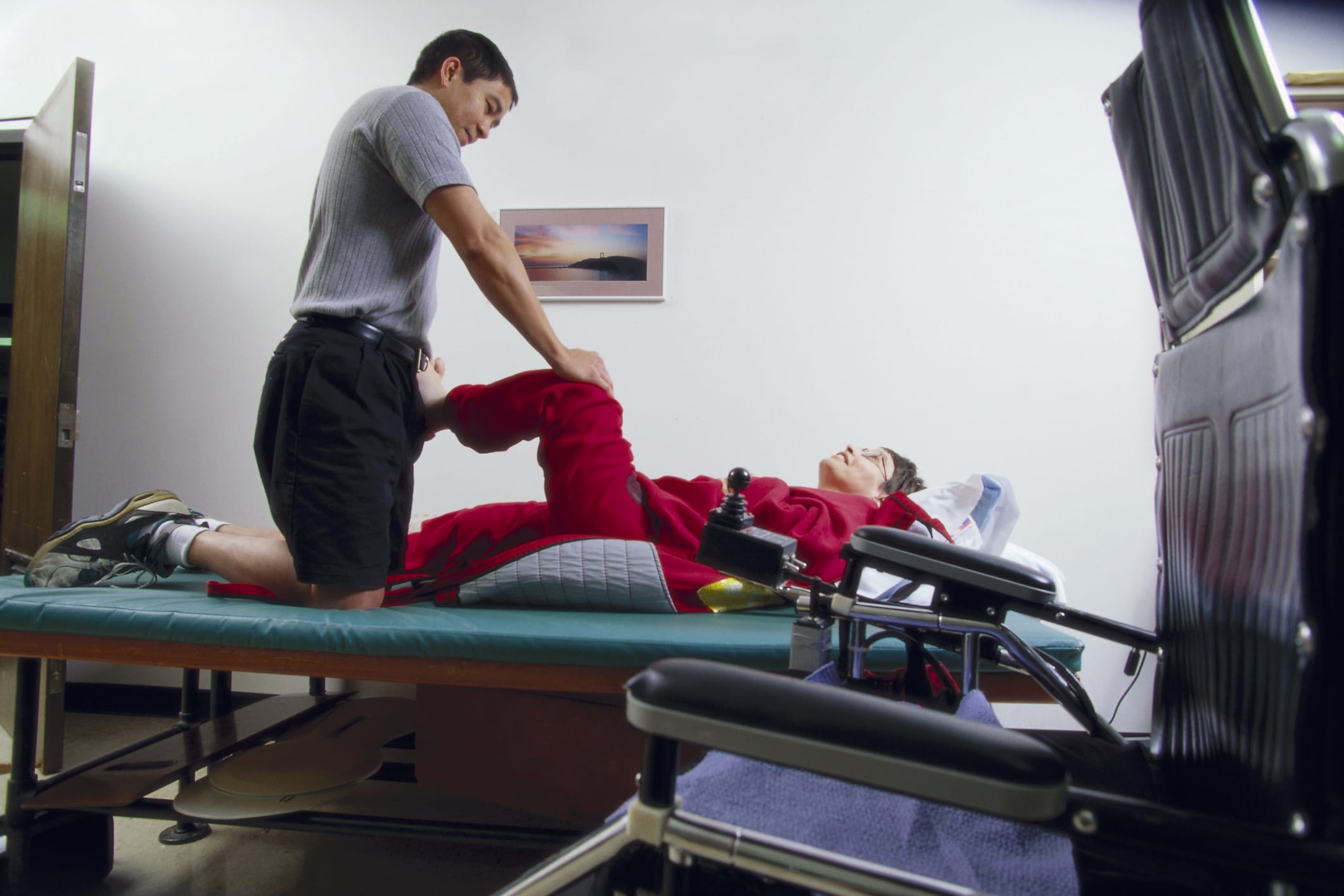Important Safety Information
When receiving ITB TherapySM with Lioresal® Intrathecal (baclofen injection), make sure you follow your clinician’s instructions closely. A sudden stop in therapy can result in serious baclofen withdrawal symptoms, such as high fever, changed mental status, muscle stiffness, and in rare cases, may result in the loss of function of many vital organs and death. It is critical that your clinician be called right away if you experience any of these symptoms. Make sure you keep your scheduled refill visits so you don’t run out of medication (baclofen). You should also know the early symptoms of baclofen withdrawal. Some people are at more risk than others for baclofen withdrawal; speak with your clinician about this.
Q: What is Lioresal® Intrathecal (baclofen injection)?
A: Lioresal® Intrathecal (baclofen injection) is a muscle relaxant and antispastic medication that is used for treatment of severe spasticity caused by injury to or certain conditions of the brain or spinal cord.
Q: What is severe spasticity?
A: Severe spasticity is a condition that results from an injury to or disease of the brain or spinal cord. Spasticity may make your muscles feel tight, stiff and difficult to move. With severe spasticity, you can experience stiffening of the muscles that makes your muscles feel like they are locked, or even jerk uncontrollably when you try to use them.
Q: What is ITB TherapySM?
A: Intrathecal Baclofen Therapy (ITB) is a treatment using Lioresal® Intrathecal (baclofen) that is delivered into the fluid around your spinal cord (intrathecal) to help manage severe spasticity. For long term treatment, the drug is placed into a pump that is surgically placed under the skin of your abdomen. The pump delivers Lioresal® Intrathecal through a small tube (catheter) into your spinal fluid. Your doctor can program the pump to deliver the appropriate daily dose for you. Before you can be considered for long term treatment, you must have a test dose to see how you respond to the drug when it is delivered in this way. After the test dose is done, your doctor will discuss the results with you and determine if you are an appropriate candidate for the therapy.
Q: Who is a candidate for ITB TherapySM?
A: People who have severe spasticity resulting from conditions of the brain or spinal cord (such as multiple sclerosis, cerebral palsy, stroke, brain injury or spinal cord injury) may be candidates for ITB TherapySM. If your spasticity is due to spinal cord injury or multiple sclerosis and is not controlled with baclofen taken by mouth or you have side effects that are not acceptable from oral baclofen taken to treat your spasticity, you may be a candidate. If you have had a brain injury due to trauma, you should wait for one year after your injury to be considered for ITB TherapySM.
Q: Who is not a candidate for ITB TherapySM or a screening test dose?
A: If you are hypersensitive to baclofen, you should not use Lioresal® Intrathecal. If you have an active infection, you should not have a screening test or implant until the infection has resolved. You should not receive ITB TherapySM if you have a body size that is too small to hold the implantable pump.
Q: What are the most common side effects of Lioresal® Intrathecal?
A: The side effects of Lioresal® Intrathecal can include drowsiness, lightheadedness, dizziness, nausea and vomiting, low blood pressure, headache, seizures, and loose muscles. As with most medications, you can experience overdose (drug dose is too high) or withdrawal (drug dose is too low). Your doctor will discuss the possible effects of Lioresal® Intrathecal and what to do if you experience any of the symptoms or side effects. Sexual dysfunction in men and women including decreased libido and orgasm dysfunction have been reported.
Q: What do I need to know if I am using Lioresal® Intrathecal?
A: All patients and caregivers should receive information on the risks of the treatment. Your doctor should give you information of the signs and symptoms of receiving too much or too little medication (overdose or withdrawal) and what to do if you notice those symptoms.
Q: What are the signs of withdrawal from Lioresal® Intrathecal?
A: An increase in your spasticity, itching, low blood pressure, lightheadedness, and a tingling sensation are the most common signs with sudden withdrawal from Lioresal® Intrathecal. In rare cases, severe withdrawal symptoms may occur including high fever, change in mental status, extreme spasticity that is worse than before starting Lioresal® Intrathecal and muscle rigidity. If you experience any of these signs, it is extremely important that you or your caregiver contact your doctor immediately. If the sudden withdrawal is not treated, in rare cases, more severe medical conditions can develop that can result in death.
Q: What can I do to prevent Lioresal® Intrathecal withdrawal or abrupt interruption of Lioresal® Intrathecal?
A: It is very important that you not miss refill appointments. If you plan to travel let your doctor know so that your refill can be scheduled so that you don’t run out of medication. If you are hospitalized for any reason near the time of your refill, you or your caregiver should let your doctor know before the refill date so that arrangements can be made to refill your pump. Not all hospitals have doctors that can refill pumps, so let your doctor know as soon as possible if it is near your refill date. You should be aware of what your pump alarms sound like. If you hear an alarm, contact your doctor immediately.
Q: What are the signs of Lioresal® Intrathecal overdose?
A: Signs of receiving too much medication (overdose) can appear suddenly or gradually over a few days. Signs may include muscles being too loose, drowsiness, lightheadedness, dizziness, sleepiness, slowed or shallow breathing, lower than normal body temperature, seizures, loss of consciousness, and coma. It is very important that you or your caregiver contact your doctor immediately if you experience any of these signs and that you be taken to a hospital for treatment.
Q: What are the potential pump and catheter implant procedure complications?
A: The implanted pump and catheter are placed under the skin of the abdomen during a surgery. Some complications that you may experience with the implant surgery include infection, meningitis (infection of the lining of the brain and central nervous system), spinal fluid leak, paralysis, headache, swelling, bleeding, and bruising.
Q: What are the potential pump and catheter complications that can occur after implant?
A: Once the infusion system (the pump and the catheter) is implanted, device complications may occur that may require surgery to remove or replace the pump, catheter or catheter fragment. Some of these device complications may impact the flow of medication delivered, which may cause symptoms of overdose or withdrawal of Lioresal® Intrathecal.
Possible complications include an internal component failure which may result in a loss of therapy, or an inability to program the pump. The pump, catheter or catheter fragment could migrate within the body or erode through the skin. Tissue or an inflammatory mass may form at the tip of the catheter in the intrathecal space and may cause a loss of therapy or neurological impairment including paralysis. The catheter could leak, tear or become disconnected resulting in delivery of medication into the area under the skin where the pump is implanted and/or along the catheter path. The catheter could kink or become blocked resulting in no delivery of medication. The pump could stop because the battery has run out or because of a problem with one or more of its inner parts. Errors in locating the pump during the refill procedure can result in symptoms of overdose that may be serious or life-threatening.
Q: Can I undergo Magnetic Resonance Imaging (MRI) testing?
A: Under certain conditions, an MRI can be conducted with the pump. Always inform your doctor that you have an implanted infusion system before any medical or diagnostic procedure such as MRI or diathermy. Please ask your doctor to determine if the MRI scan can be used with the pump. The MRI will cause your pump to temporarily stop, which will suspend drug delivery during the MRI. The pump should resume normal operation and drug delivery after the MRI is complete. Your pump may also temporarily sound an alarm during the scan; the alarm should stop at the conclusion of the scan. Following your MRI, your doctor should check your pump to confirm that it is working properly.
You are encouraged to report negative side effects of prescription drugs to the FDA.
Visit https://www.fda.gov/medwatch, or call 1-800-FDA-1088.
To report adverse reactions or quality issues, contact Amneal at:
Phone: 1(877) 835-5472
Email: Drugsafety@amneal.com
Mail: Amneal Pharmaceuticals, 50 Horseblock Road, Brookhaven, New York 11719
The risk information provided here is not comprehensive. To learn more, talk about ITB TherapySM and Lioresal® Intrathecal with your doctor and refer to the FDA-approved product labeling.
Lioresal® is a registered trademark of Amneal Pharmaceuticals.
Rx Only Rev 1216

